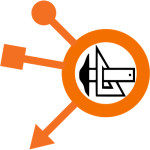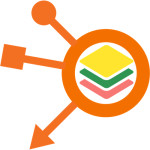OpenLayer the Application Integration & Business Process Optimization solution
OpenLayer™ is an innovative framework which divides front-end activities and back-end technology services of legacy systems. OpenLayer encapsulates the user facing, front-end actions and allows easy access to business process-flows. OpenLayer™ is both a “bridge to the cloud” and a cost effective, low risk and user centric
way to access and integrate workflows across business critical, legacy systems. OpenLayer™ is the solution for Application Integration & Business Process Optimization.
OpenLayer™ Value
OpenLayer delivers on three critical requirements:
- Access: Anytime / Anywhere Access to any business application via any web browser
- Extend: Personalize user experience across internal, external and cloud service
- Integration: Minimize Application & Business Process Integration time by eliminating the need for application and data base level development
OpenLayer allows you to retain full control of any integration project OpenLayer is architected to facilitate the integration of diversified systems and fulfills the need of bridging legacy systems with modern cloud based systems. OpenLayer keeps “System of Record” (Mode 1 of bimodal IT) and “System of Agility” (Mode 2), in harmony without requiring any changes to the legacy (Mode 1) environment.
OpenLayer addresses the changing rule of traditional IT
Govern Shadow IT and embrace Citizen Integrators1:
Today more IT budget is allocated to the line of business (LOBs), sometimes at the expense of the central IT budget. This impacts requirements for integration because individual LOBs often have business specific requirements. One consequence of this is that, by 2017, at least 65% of new integration flows will be developed outside of central IT2.
This makes a strong case for Citizen Integration, but IT leaders are often unprepared to deal with Citizen Integrators, nevertheless IT leaders can add value to the organization by facilitating Citizen Integrators while ensuring effective Governance is in place to minimize organizational risk.
Improve Business Process Optimization:
Organizations have historically struggled to prioritize and fund Business Process Integration/Optimization efforts. With OpenLayer, companies can now Integrate Application and process Functionality, at the End User level, without the need for applications and/or data base level development. This approach, by relying on existing business user functions, facilitates swift, cost effective, and risk free integration.
Accelerate Delivery of Mobile Applications:
Enterprise IT organizations are being asked to deliver large numbers of mobile apps, often outstripping the resources that they have available3. The risk to both IT and the Business is having LOBs go outside IT to contract with third-party development firms to build customer-facing mobile apps, as they see these as a critical part to their digital business activities.
By dividing front-end development activities from back-end services using OpenLayer, IT organizations can deliver a powerful portfolio of mobile apps by enabling third parties and LOB units to rapidly create effective client apps with a focus on a strong user experience. Most importantly this enables IT to maintain governance and control without impacting agility, quality or speed of deployment.
Modernize legacy applications and platforms
Additionally, organizations continue to be faced with the challenges of valuable, albeit aging, application portfolios, a difficult economy and the pending retirement of baby boomers, thus requiring them to make and execute modernization decisions for legacy applications and legacy computing platforms. Many legacy application modernization initiatives are driven by a company’s desire to make applications more efficient and cost-effective. Budget and time overruns of legacy modernization projects are frequent, and many modernization efforts stall due to the organization’s requirements to retain legacy data and the perceived difficulty in doing so. The roots of this challenge are often found in the nature of these applications: They are complex, loosely coupled and often homegrown and date back decades.
OpenLayer executive summary
OpenLayer is the leading next generation Application Integration & Business Process Optimization solution. OpenLayer provides organizations a new and innovative alternative to traditional integration and optimization approaches.
OpenLayer is:
- Versatile: Application and Database agnostic
- Non-Disruptive: No server or application code changes required
- Easy: Access any application from any browser on any device
- Cost Effective: Protects your organization core business rule while enabling process improvement
- Mitigates Risk: By leveraging existing business process, no new risk is introduced to the organization
- Flexible: Supports Citizen Integration models across the Line of Business and IT organizations
Use Case scenarios
Technology Inventory:
An organization has a home grown ERP, a cloud based CRM, a clipboard to take notes and pass to back-office operators for data entry.
Deliverable:
The solution must provide:
- A real-time integration between cloud based CRM and ERP, on demand.
- Integration with ERP must obey existing business rules
- Zero business disruption or downtime
- Access to workers in field and stakeholders access the ERP system in real time.
- Users should be able to personalize their view and only have access to needed data.
The OpenLayer Solution:
OpenLayer exposed all transactions in the home-grown ERP to any browser enabled device. OpenLayer did not require any change in the server code or any client software installation. The auto generated, highly responsive and customizable user interface enabled the workers in the field and other stake holders to access the application using their mobile devices. The “Extend and personalize” wizard of OpenLayer also permitted users to personalize their user experience and translate into their local language.
The scripting engine of OpenLayer, allowed sales team to develop RESTful API, using4 the navigation and add / change a sales order in ERP. This API was then called as a trigger from cloud based CRM. This mechanism synchronized the CRM and ERP in real time without any user intervention.
OpenLayer delivers an optimized outcome
As OpenLayer did not require any change in the server code of ERP, the highly productive legacy users continued to be productive as their user experience did not change. OpenLayer exposed the order entry process and exposed it to Citizen Integrators, by empowering them made it easier to synchronize their sales data from cloud based CRM and sales order in ERP. OpenLayer helped the organization embrace bimodal IT, harmonize their Mode 1 and Mode 2 systems and allowed users to automate system connections without IT intervention in a secure and controlled manner.

Configurable UI
OpenLayer supports a robust User Experience (UX), personalized for user, group, and system.

No Code Changes
OpenLayer preserves all existing application business logic. No Customer Application nor Database coding is required.
References
1 Gartner has recently coined the term “Citizen Integrator” to refer to business users taking integration into their own hands. Organizations cannot afford to wait for IT to integrate and connect disparate applications. By strategically fostering citizen integration, IT can enable business users to automate connections themselves; saving valuable resources and ensuring users have what they need – when they need it. These people must be empowered to do so with tools, such as OpenLayer, which make it easier to synchronize their data across their systems (System of Innovation) and their corporate systems (System of Records). In addition, this approach ensures that IT professionals to focus on strategic initiatives.
2 Embrace the Citizen Integrator Approach to Improve Business Users’ Productivity and Agility by Massimo Pezzini – Gartner Analyst
3 IT Organizations Should Focus on Middleware to Enable Mobile App Development by Van L. Baker | Richard Marshall – Gartner Analyst
4 Representational State Transfer (REST) is a software architecture style consisting of guidelines and best practices for creating scalable web services. REST is a coordinated set of constraints applied to the design of components in a distributed hypermedia system that can lead to a more performant and maintainable architecture. REST has gained widespread acceptance across the web as a simpler alternative to SOAP and WSDL-based web services. RESTful systems typically, but not always, communicate over the Hypertext Transfer Protocol with the same HTTP verbs used by web browsers to retrieve web pages and send data to remote servers. REST interfaces usually involve collections of resources with identifiers. The REST architectural style was developed by W3C Technical Architecture Group (TAG) in parallel with HTTP. – Source: Wikipedia







